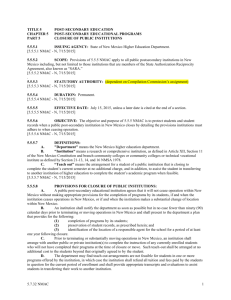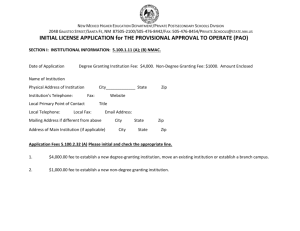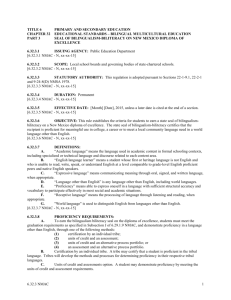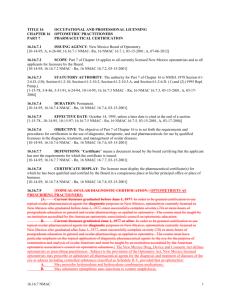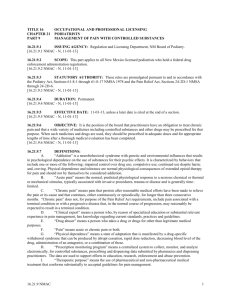16.16.7 NMAC - Regulation and Licensing Department
advertisement
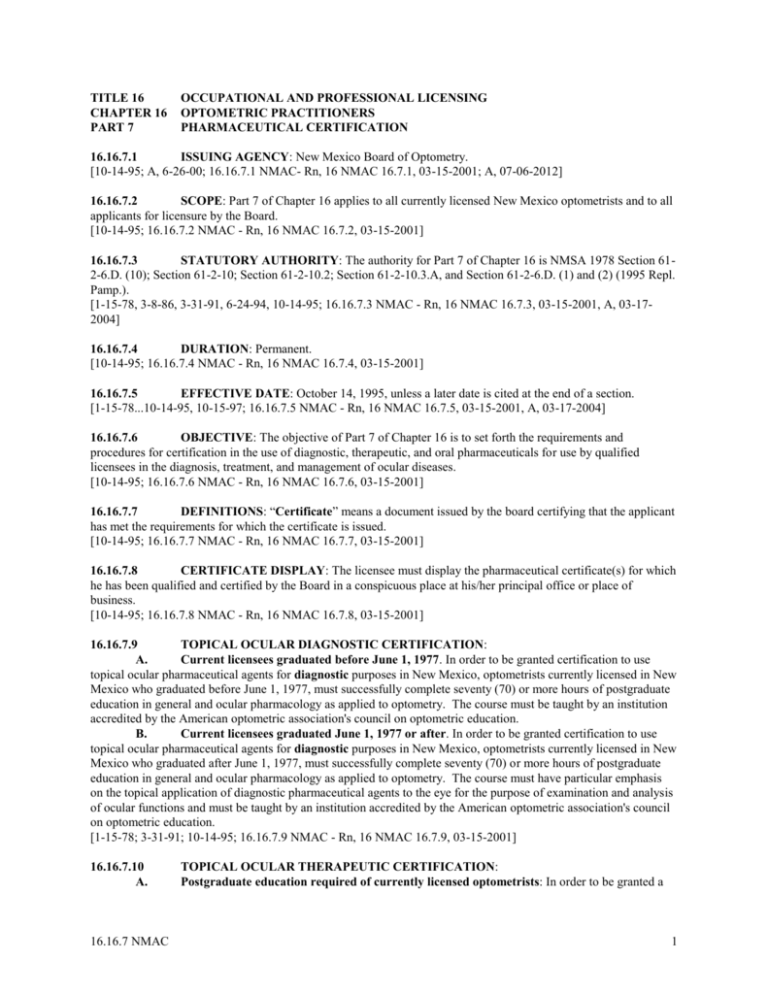
TITLE 16 CHAPTER 16 PART 7 OCCUPATIONAL AND PROFESSIONAL LICENSING OPTOMETRIC PRACTITIONERS PHARMACEUTICAL CERTIFICATION 16.16.7.1 ISSUING AGENCY: New Mexico Board of Optometry. [10-14-95; A, 6-26-00; 16.16.7.1 NMAC- Rn, 16 NMAC 16.7.1, 03-15-2001; A, 07-06-2012] 16.16.7.2 SCOPE: Part 7 of Chapter 16 applies to all currently licensed New Mexico optometrists and to all applicants for licensure by the Board. [10-14-95; 16.16.7.2 NMAC - Rn, 16 NMAC 16.7.2, 03-15-2001] 16.16.7.3 STATUTORY AUTHORITY: The authority for Part 7 of Chapter 16 is NMSA 1978 Section 612-6.D. (10); Section 61-2-10; Section 61-2-10.2; Section 61-2-10.3.A, and Section 61-2-6.D. (1) and (2) (1995 Repl. Pamp.). [1-15-78, 3-8-86, 3-31-91, 6-24-94, 10-14-95; 16.16.7.3 NMAC - Rn, 16 NMAC 16.7.3, 03-15-2001, A, 03-172004] 16.16.7.4 DURATION: Permanent. [10-14-95; 16.16.7.4 NMAC - Rn, 16 NMAC 16.7.4, 03-15-2001] 16.16.7.5 EFFECTIVE DATE: October 14, 1995, unless a later date is cited at the end of a section. [1-15-78...10-14-95, 10-15-97; 16.16.7.5 NMAC - Rn, 16 NMAC 16.7.5, 03-15-2001, A, 03-17-2004] 16.16.7.6 OBJECTIVE: The objective of Part 7 of Chapter 16 is to set forth the requirements and procedures for certification in the use of diagnostic, therapeutic, and oral pharmaceuticals for use by qualified licensees in the diagnosis, treatment, and management of ocular diseases. [10-14-95; 16.16.7.6 NMAC - Rn, 16 NMAC 16.7.6, 03-15-2001] 16.16.7.7 DEFINITIONS: “Certificate” means a document issued by the board certifying that the applicant has met the requirements for which the certificate is issued. [10-14-95; 16.16.7.7 NMAC - Rn, 16 NMAC 16.7.7, 03-15-2001] 16.16.7.8 CERTIFICATE DISPLAY: The licensee must display the pharmaceutical certificate(s) for which he has been qualified and certified by the Board in a conspicuous place at his/her principal office or place of business. [10-14-95; 16.16.7.8 NMAC - Rn, 16 NMAC 16.7.8, 03-15-2001] 16.16.7.9 TOPICAL OCULAR DIAGNOSTIC CERTIFICATION: A. Current licensees graduated before June 1, 1977. In order to be granted certification to use topical ocular pharmaceutical agents for diagnostic purposes in New Mexico, optometrists currently licensed in New Mexico who graduated before June 1, 1977, must successfully complete seventy (70) or more hours of postgraduate education in general and ocular pharmacology as applied to optometry. The course must be taught by an institution accredited by the American optometric association's council on optometric education. B. Current licensees graduated June 1, 1977 or after. In order to be granted certification to use topical ocular pharmaceutical agents for diagnostic purposes in New Mexico, optometrists currently licensed in New Mexico who graduated after June 1, 1977, must successfully complete seventy (70) or more hours of postgraduate education in general and ocular pharmacology as applied to optometry. The course must have particular emphasis on the topical application of diagnostic pharmaceutical agents to the eye for the purpose of examination and analysis of ocular functions and must be taught by an institution accredited by the American optometric association's council on optometric education. [1-15-78; 3-31-91; 10-14-95; 16.16.7.9 NMAC - Rn, 16 NMAC 16.7.9, 03-15-2001] 16.16.7.10 A. 16.16.7 NMAC TOPICAL OCULAR THERAPEUTIC CERTIFICATION: Postgraduate education required of currently licensed optometrists: In order to be granted a 1 certificate to administer and prescribe topical ocular therapeutic pharmaceutical agents, all optometrists currently licensed in New Mexico must provide the following documentation to the board: (1) Proof of successful completion and examination in a one hundred (100) hour course in general and ocular pharmacology, including therapeutic pharmacology as applied to optometry, with particular emphasis on the application of pharmaceutical agents to the eye for the purpose of examination and analysis of ocular functions and the treatment of visual defects or abnormal conditions of the human eye and its adnexa; (2) Proof that the course was taught by an institution accredited by the American optometric association's council on optometric education; and (3) The required fee for a pharmaceutical certificate (16.16.2.12 NMAC). B. Postgraduate education required of applicants for licensure: (1) All optometry licensure applicants must provide the same documentation required in Subsection A of 16.16.7.10 NMAC before sitting for the board's licensing exam. (2) After the applicant has met all licensure requirements, has successfully passed the board exam, and paid the required license and certificate fees, a license and an ocular therapeutic certificate will be issued to the applicant. [3-8-86; 10-14-95; 16.16.7.10 NMAC - Rn, 16 NMAC 16.7.10, 03-15-2001; A, 03-22-2008] 16.16.7.11 ORAL PHARMACEUTICAL CERTIFICATION: A. The certificate issued pursuant to the provisions in Section 61-2-10.2 of the Optometry Act allows the qualified optometrist to administer and prescribe the following classes of oral pharmaceutical drugs in the treatment and management of ocular disease: (1) anti-infective medications, not including antifungals; (2) anti-glaucoma medications, not including osmotic medications; (3) anti-allergy medications; (4) anti-inflammatory medications, not including oral corticosteroids and immunosuppression agents; and (5) analgesic medications, including schedule III through V controlled substances, as provided in the Controlled Substances Act. B. Requirements for currently licensed New Mexico optometrists. In order for an optometrist currently licensed in the State of New Mexico to be granted certification to use the oral pharmaceutical agents listed in Subsection A of 16.16.7.11 NMAC, the optometrist must first: (1) be certified in New Mexico in the use of topical ocular pharmaceuticals in accordance with 16.16.7.10 NMAC. (2) provide proof of successful completion and examination in a board-approved course of instruction consisting of at least twenty (20) hours in clinical pharmacology, including systemic pharmacology as applied to optometry with particular emphasis on the administration of oral pharmaceutical agents for the purpose of examination of the human eye, and analysis of ocular functions and treatment of visual defects or abnormal conditions of the human eye and its adnexa. (3) provide proof the course was taught by an institution accredited by the American optometric association's council on optometric education. C. Postgraduate education required of applicants for licensure: (1) Licensure applicants graduated from optometry school prior to the 1994-1995 academic period must provide the board with the same documentation required in Subsection B of 6.16.7.11 NMAC. (2) Licensure applicants receiving doctor of optometry degrees in the 1994-1995 academic year and thereafter have obtained the required number of academic hours required for the oral pharmacology course in their optometric program to meet the certification requirement for the administration and prescription of oral pharmaceutical agents in New Mexico. [10-14-95; A, 6-26-00; 16.16.7.11 NMAC - Rn, 16 NMAC 16.7.11, 03-15-2001; A, 03-22-2008] 16.16.7.12 DEA REGISTRATION REQUIRED: Before a New Mexico optometric physician may administer, dispense, or prescribe any of the controlled substances which are allowed by the Optometry Act (Section 61-2-10.2) and for which a DEA registration is required, he/she must be registered by the New Mexico board of pharmacy and by the United States drug enforcement administration as provided in 16.16.8 NMAC. [10-14-95; 16.16.7.12 NMAC - Rn, 16 NMAC 16.7.12, 03-15-2001; A, 07-06-2012] 16.16.7 NMAC 2 16.16.7.13 “OPTOMETRIC PHYSICIAN” TITLE USE: Only those optometrists who have been certified as provided in 16.16.7.11 NMAC may use the title of “optometric physician”. [10-15-97; 16.16.7.13 NMAC - Rn, 16 NMAC 16.7.13, 03-15-2001; A, 03-22-2008; A, 07-06-2012] 16.16.7.14 PRESCRIPTION FOR PHARMACEUTICAL AGENTS: A prescription written for a topical ocular pharmaceutical agent or for an oral pharmaceutical agent shall include an order given individually for the person for whom prescribed, either directly from the prescriber to the pharmacist or indirectly by means of a written order signed by the prescriber, that bears the following items: A. the name and address of the prescriber; B. the prescriber’s professional designation; C. the name and address of the patient; D. the name and quantity of the agent being prescribed; E. directions for the use of the agent; F. the prescription issue date; and G. the number of refills allowed. [16.16.7.14 NMAC - N, 03-17-2004] 16.16.7.15 OPTOMETRIC PHYSICIAN CERTIFICATION REQUIREMENT: All New Mexico licensed optometrists graduated from optometry school prior to the 1994-1995 academic year, must complete the requirements for certification in the use of oral pharmaceutical agents prior to July 1, 2013, as required in Subsection B of 16.16.7.11 NMAC. [16.16.7.15 NMAC - N, 03-22-2008] HISTORY of 16.16.7 NMAC: Pre-NMAC History: Material in the part was derived from that previously filed with the commission of public records - state records center and archives: OEB 73-1, Rule No. 1 of Administrative Rules and Regulations of the State Board of Examiners in Optometry, filed 10-18-73. NMBO Rule 12, - Board Rule No. 12 - Requirements for Pharmacology Certificate, filed 3-1-91. OPT Rule No. 17 - Education Requirements, Therapeutic Pharmaceutical Agents, filed 2-6-86. History of Repealed Material: [Reserved] Other History: 16 NMAC 16.7, Pharmaceutical Certification, filed 9-21-95, replaced that relevant portion of NMBO Rule 12 and OPT Rule No. 17. 16 NMAC 16.7, Pharmaceutical Certification, filed 9-21-95, renumbered and reformatted to 16.16.7 NMAC, Pharmaceutical Certification, effective 03-15-2001. 16.16.7 NMAC 3
